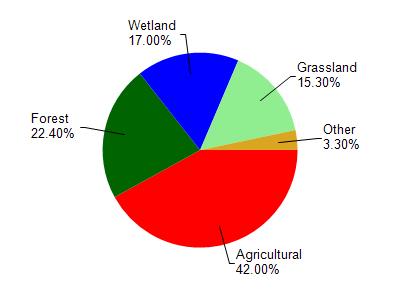Wood
No
No
Yes
Fish and Aquatic Life
Overview
Biotic index sampling conducted in 1990 indicates good to very good water quality in the upper reaches of the creek but fair near the confluence with the Yellow River.
Mid-American Nursing Home/Bethel Convalescent Center discharges its effluent to drainage ditch flowing into this unnamed creek. This unnamed creek is a tributary of the Yellow River
Date 2002
Author Aquatic Biologist
Impaired Waters
The 2018 assessments of this Unnamed Tributary (WBIC 1371200) showed impairment by phosphorus; existing total phosphorus sample data overwhelmingly exceeded the 2018 WisCALM listing criteria for the Fish and Aquatic Life use. However, available biological data did not indicate impairment (i.e. no macroinvertebrate or fish Index of Biotic Integrity (IBI) scored in the "poor" condition category). Based on the most updated information, this water was proposed for the impaired waters list.
Date 2017
Author Ashley Beranek
Condition
Wisconsin has over 84,000 miles of streams, 15,000 lakes and milllions of acres of wetlands. Assessing the condition of this vast amount of water is challenging. The state's water monitoring program uses a media-based, cross-program approach to analyze water condition. An updated monitoring strategy (2015-2020) is now available. Compliance with Clean Water Act fishable, swimmable standards are located in the Executive Summary of Water Condition in 2018. See also the 'monitoring and projects' tab.
Reports
Management Goals
Wisconsin's Water Quality Standards provide qualitative and quantitative goals for waters that are protective of Fishable, Swimmable conditions [Learn more]. Waters that do not meet water quality standards are considered impaired and restoration actions are planned and carried out until the water is once again fishable and swimmable
Management goals can include creation or implementation of a Total Maximum Daily Load analysis, a Nine Key Element Plan, or other restoration work, education and outreach and more. If specific recommendations exist for this water, they will be displayed below online.
Monitoring
Monitoring the condition of a river, stream, or lake includes gathering physical, chemical, biological, and habitat data. Comprehensive studies often gather all these parameters in great detail, while lighter assessment events will involve sampling physical, chemical and biological data such as macroinvertebrates. Aquatic macroinvertebrates and fish communities integrate watershed or catchment condition, providing great insight into overall ecosystem health. Chemical and habitat parameters tell researchers more about human induced problems including contaminated runoff, point source dischargers, or habitat issues that foster or limit the potential of aquatic communities to thrive in a given area. Wisconsin's Water Monitoring Strategy was recenty updated.
Grants and Management Projects
| Project Name (Click for Details) | Year Started |
|---|
|
|
Monitoring Projects
| WBIC | Official Waterbody Name | Station ID | Station Name | Earliest Fieldwork Date | Latest Fieldwork Date | View Station | View Data |
|---|
| 1371200 | Unnamed | 723154 | Creek 10-12 (Otter Cr) - Cth A | 10/21/1992 | 10/21/1992 | Map | Data |
| 1371200 | Unnamed | 10016231 | Creek 10-12 - App. 100 Yds. Above The Bridge Ongrant Rd. Riffle Just Above Sharp Turn Inthe Creek | 5/17/1990 | 5/17/1990 | Map | Data |
| 1371200 | Unnamed | 723139 | Unn Ck 10-12 at Cth C And A | 4/17/1991 | 8/6/2025 | Map | Data |
| 1371200 | Unnamed | 10016417 | Creek 10-12 - 30 Yds. Above Bridge On Cth-C | 5/17/1990 | 5/17/1990 | Map | Data |
|

Watershed Characteristics
Unnamed is located in the Upper Yellow (Wood Co.) River watershed which is 212.95 mi². Land use in the watershed is primarily agricultural (42%), forest (22.40%) and a mix of wetland (17%) and other uses (18.60%). This watershed has stream miles, lake acres and 22,147.27 wetland acres.
Nonpoint Source Characteristics
This watershed is ranked High for runoff impacts on streams, High for runoff impacts on lakes and High for runoff impacts on groundwater and therefore has an overall rank of High. This value can be used in ranking the watershed or individual waterbodies for grant funding under state and county programs.However, all waters are affected by diffuse pollutant sources regardless of initial water quality. Applications for specific runoff projects under state or county grant programs may be pursued. For more information, go to surface water program grants.